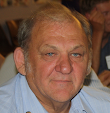ANZAC DAY EDITION
Based on the grounds of
the Villers-Bretonneux Military Cemetery
in Northern France, the Sir John
Monash Centre
is a poignant part of the Western Front.
The official opening of The Sir John Monash Centre
took place at
5.00pm France time, 24 April 2018.
Sir John Monash
Australian military commander of the First
World War.
He commanded the 13th
Infantry Brigade before the war
and then, shortly after its outbreak,
became commander of the 4th Brigade in Egypt,
with whom he took part in
the Gallipoli
campaign.
In July 1916 he took
charge of the newly raised 3rd
Division
in northwestern France
and in May 1918
became commander of the Australian Corps, at the time
the largest corps on the Western
Front.
The successful Allied attack at the Battle of Amiens
on 8 August 1918
, which expedited the end
of the war,
was planned by Monash and spearheaded
by British forces including
the Australian and Canadian Corps
under Monash and Arthur Currie.
Monash is considered one of the best Allied generals
of the
First World War and the most famous commander in Australian history
James Dexter tells the incredible story of his
grandfather
Walter who fought in the Boer War
and later became one of the
longest-serving
and most highly decorated chaplains in the AIF.
Walter, whose
story is shared in Albany's National Anzac Centre,
was also responsible for
mapping the cemeteries
on Gallipoli before the Anzacs were evacuated in December 1915
ANZAC humour
National ANZAC centre Albany
The award winning National
Anzac Centre
is one of Australia's most important
cultural pilgrimages.
Located within Albany's heritage listed Princess Royal
Fortress,
the centre overlooks the actual harbour
from which over 41,000 men
and woman
departed Australia for the Great War
Albany (WA) was the gathering
point for the first two convoys
carrying the Australian Imperial Force and New
Zealand Expeditionary Force,
before they departed for the war.
These troops
were later to be known as the Anzacs.
The National Anzac Centre is Australia’s
foremost museum
dedicated solely to honouring the Anzacs of the First World
War.
Set within Albany Heritage Park, Western Australia
, the Centre offers
visitors a deeply personal connection
with the Anzac story revealed through
interactive multimedia displays,
unique artefacts, rare images and film, and
audio commentary.
The National Anzac Centre was
opened by the
Prime Ministers of Australia and New Zealand and the Premier of
Western Australia
on 1 November 2014
: the centenary of the first convoy’s
departure for war.
The Desert Mounted Corps
Memorial atop Mount Clarence.
Although the statue is a recast of the original
statue
erected at Suez, Egypt in 1932,
the granite blocks are the originals,
bullet marks can still be seen on them.
Peter FitzSimons tells the story of the men who went into battle
at Lone Pine and The Nek a century ago
in a desperate attempt to break the three-month stalemate.
Archie Barwick's diary entries from Lone Pine again
capture the brutality of the campaign
and iconic scenes from Peter Weir's Gallipoli are featured.
Having had ANZAC Day commemorations and memorials,
this Lady felt inspired to pay her own tribute to the brave
ANZAC's,
including both of her Great Grandfather's.
Sadly, neither of them made it
home.
To those who served then and
to those who serve now, thank you.
Here is her rendition of
The Last Post
The Last Post- Violin















































No comments:
Post a Comment